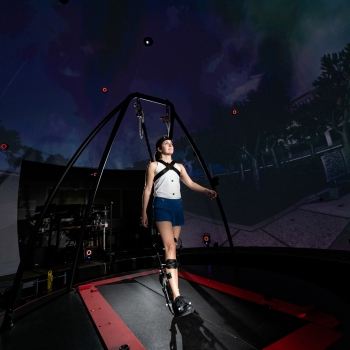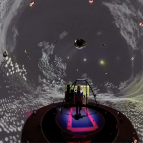Human-Exoskeleton Fluency
Exoskeletons are wearable devices designed to augment human movement by restoring, maintaining, or enhancing performance. The U.S. government has supported the research and development of exoskeleton technologies with goals to improve metabolic efficiency during extended dismounted and overground maneuvers as well as to reduce injury risk during heavy load carriage and repetitive lifting tasks. A major limitation of current exoskeleton systems is in the controller design. Existing controllers are often described as sluggish or awkward because they typically lag human movement, and they are often optimized for tasks such as steady-state locomotion. The reactive nature of these controllers limits their ability to handle transitions between different speeds or terrain. Unlike other autonomous systems, wearable exoskeletons require tightly coupled human-in-the-loop control, and co-adaptation between the human and exoskeleton is critical to achieving fluency.

The goal of the Human-Exoskeleton Fluency research program is to evaluate and develop a fluid, intuitive exoskeleton system that can be easily embodied by the operator. In collaboration* with researchers at the University of Michigan and MIT campus, we demonstrated the following capabilities on an exoskeleton system:
- prediction of an operator’s movement from wearable sensors
- control of the exoskeleton’s assistance based on those predictions and a model of the soleus muscle
- augmentation of an operator’s sensory feedback to support rapid adaptation to the exoskeleton
This prototype technology was developed by building upon a commercially available ankle exoskeleton system (Dephy Inc.). The research team leveraged the Computer Assisted Rehabilitation Environment (CAREN) system to record how individuals walk under a variety of terrain inclines and walking speeds, as well as while carrying different loads. From these data, individualized machine learning models were trained to predict biomechanical properties (e.g., ankle torque) from wearable sensors (e.g., electromyography, accelerometry) in real time. The team reported that ankle torques could be accurately predicted up to 0.4 seconds ahead of time, potentially as controller input to provide appropriate assistance [1].
The team identified that people exhibited different muscle activity when adapting to wearing the exoskeleton [2], underscoring the importance of individualized models and understanding muscle adaptation timelines. Despite those differences, pre-training the prediction model on data from a group of people before applying it to a new user significantly sped up the training and lowered data requirements [3].
In order to evaluate the impact of the predictive algorithms, the exoskeleton system was outfitted with a wearable system that predicted the operator’s movement intent and provided the appropriate torque assistance. This system recorded real-time muscle activity from the legs, conditioned the physiological signals, and predicted ankle torque, leveraging trained deep learning models for each individual. Other experiments investigated the effects of haptic cues on the users’ legs and how they changed the biomechanics of using the exoskeleton [4], as well as what effects the exoskeleton had on human balance.
The results of this program offer new insight into the use of biomechanics, human experiments, and machine learning to develop not just better exoskeletons, but more fluent human-exoskeleton teams.
*Collaborators
Leia Stirling, PhD, University of Michigan: https://stirling.engin.umich.edu/
Paul Stegall, PhD, Northern Arizona University: https://scholar.google.com/citations?user=zJZR6FQAAAAJ&hl=en
- H.C. Siu, J. Sloboda, R.J. McKindles, and L.A. Stirling, “A Neural Network Estimation of Ankle Torques from Electromyography and Accelerometry,” IEEE Transactions on Neural Systems and Rehabilitation Engineering, vol. 29, pp. 1624–1633, 2021.
- Y. Acosta-Sojo and L. Stirling, “Individuals Differ in Muscle Activation Patterns During Early Adaptation to a Powered Ankle Exoskeleton,” Applied Ergonomics, vol. 98, article no. 103593, 2022.
- J. Sloboda, P. Stegall, R.J. McKindles, L. Stirling, and H.C. Siu, “Utility of Inter-subject Transfer Learning for Wearable-Sensor-Based Joint Torque Prediction Models,” paper in Proceedings of the 43rd Annual International Conference of the IEEE Engineering in Medicine & Biology Society (EMBC), pp. 4901–4907. virtual, Nov. 1–5, 2021.
- M.I. Wu, P. Stegall, H.C. Siu, and L. Stirling, “Impact of Haptic Cues and an Active Ankle Exoskeleton on Gait Characteristics,” Human Factors, 2022.

